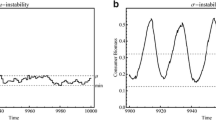Abstract
The relation between diversity and the interaction of species in ecosystems has been studied using a population dynamics model with scale-invariant interaction terms where new species are introduced randomly. This model was shown to be the minimal model for reproducing some basic characteristic features of real ecosystems not only qualitatively, but also quantitatively. It was found that there are two phases in ecoevolution dynamics, named the steady and diversifying phases. The number of species in all ecosystem is finite in the steady phase, and it increases with time in the diversifying phase. The transition between these phases is continuous, and a transition exponent was estimated. It was also found that a larger λ gives both stability and enforcement to the interactions.
Similar content being viewed by others
Explore related subjects
Discover the latest articles, news and stories from top researchers in related subjects.References
Gardner MR, Ashby WR (1970) Connectance of large dynamic (cybernetic) systems: critical values for stabiligy. Nature 228:784
May RM (1972) Will a Large Complex System be stable? Nature 238:413–414
Robert A (1974) The stability of a feasible random ecosystem. Nature 251:607–608
Neutel AM, Heesterbeek AP, de Ruiter PC (2002) Stability in real food webs: weak links in long leaps. Science 296:1120–1123
Kondoh M (2003) Foraging adaptation and the relationship between food-web complexity and satability. Science 299:1388
Tokita K, Yasutorni A (2003) Emergence of complex and stable network in a model ecosystem with extinction and mutation. Theor Pop Biol 63:131–146
Shimada T, Yukawa S, Ito N (2002) Self-organization in an ecosystem. Artif Life Robotics 6:78–81
Shimada T, Yukawa S, Ito N (2003) Life-span of families in fossil data forms q-exponential distribution. Int J Mod Phys C 14: 1267–71
Shimada T, Murase Y, Yukawa S, et al (2006) A simple model of evolving ecosystems. Artif Life Robotics 11:153–156
Catania KC, Remple FE (2005) Asymptotic prey profitability drives star-nosed males to the foraging speed limit. Nature 433: 519–522
Author information
Authors and Affiliations
Corresponding author
Additional information
This work was presented in part at the 13th International Symposium on Artificial Life and Robotics, Oita, Japan, January 31–February 2, 2008
About this article
Cite this article
Murase, Y., Shimada, T. & Ito, N. Phase diagram and stability of ecosystems. Artif Life Robotics 13, 460–463 (2009). https://doi.org/10.1007/s10015-008-0602-9
Received:
Accepted:
Published:
Issue Date:
DOI: https://doi.org/10.1007/s10015-008-0602-9




